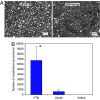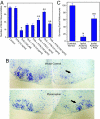Pleiotrophin is a neurotrophic factor for spinal motor neurons
- PMID: 17360581
- PMCID: PMC1838658
- DOI: 10.1073/pnas.0603243104
Pleiotrophin is a neurotrophic factor for spinal motor neurons
Abstract
Regeneration in the peripheral nervous system is poor after chronic denervation. Denervated Schwann cells act as a "transient target" by secreting growth factors to promote regeneration of axons but lose this ability with chronic denervation. We discovered that the mRNA for pleiotrophin (PTN) was highly up-regulated in acutely denervated distal sciatic nerves, but high levels of PTN mRNA were not maintained in chronically denervated nerves. PTN protected spinal motor neurons against chronic excitotoxic injury and caused increased outgrowth of motor axons out of the spinal cord explants and formation of "miniventral rootlets." In neonatal mice, PTN protected the facial motor neurons against cell death induced by deprivation from target-derived growth factors. Similarly, PTN significantly enhanced regeneration of myelinated axons across a graft in the transected sciatic nerve of adult rats. Our findings suggest a neurotrophic role for PTN that may lead to previously unrecognized treatment options for motor neuron disease and motor axonal regeneration.
Conflict of interest statement
The authors declare no conflict of interest.
Figures





Similar articles
-
Transforming growth factor-beta and forskolin attenuate the adverse effects of long-term Schwann cell denervation on peripheral nerve regeneration in vivo.Glia. 2002 Mar 1;37(3):206-18. doi: 10.1002/glia.10022. Glia. 2002. PMID: 11857679
-
Regulation of ciliary neurotrophic factor receptor alpha in sciatic motor neurons following axotomy.Neuroscience. 1999;91(4):1401-13. doi: 10.1016/s0306-4522(98)00717-9. Neuroscience. 1999. PMID: 10391446
-
Pleiotrophin cellular localization in nerve regeneration after peripheral nerve injury.J Histochem Cytochem. 2005 Aug;53(8):971-7. doi: 10.1369/jhc.4A6574.2005. J Histochem Cytochem. 2005. PMID: 16055750
-
The role of neurotrophic factors in nerve regeneration.Neurosurg Focus. 2009 Feb;26(2):E3. doi: 10.3171/FOC.2009.26.2.E3. Neurosurg Focus. 2009. PMID: 19228105 Review.
-
Specificity of peripheral nerve regeneration: interactions at the axon level.Prog Neurobiol. 2012 Jul;98(1):16-37. doi: 10.1016/j.pneurobio.2012.05.005. Epub 2012 May 15. Prog Neurobiol. 2012. PMID: 22609046 Review.
Cited by
-
Local Effect of Heparin Binding Neurotrophic Factor Combined With Chitosan Entubulization on Sciatic Nerve Repair in Rats.Bull Emerg Trauma. 2016 Apr;4(2):80-7. Bull Emerg Trauma. 2016. PMID: 27331064 Free PMC article.
-
Brief Electrical Stimulation Promotes Recovery after Surgical Repair of Injured Peripheral Nerves.Int J Mol Sci. 2024 Jan 4;25(1):665. doi: 10.3390/ijms25010665. Int J Mol Sci. 2024. PMID: 38203836 Free PMC article. Review.
-
Genomic and Proteomic Biomarker Discovery in Neurological Disease.Biomark Insights. 2008 Feb 9;3:73-86. doi: 10.4137/bmi.s596. Biomark Insights. 2008. PMID: 19578496 Free PMC article.
-
Sustained Hox5 gene activity is required for respiratory motor neuron development.Nat Neurosci. 2012 Dec;15(12):1636-44. doi: 10.1038/nn.3242. Epub 2012 Oct 28. Nat Neurosci. 2012. PMID: 23103965 Free PMC article.
-
ALK Signaling and Target Therapy in Anaplastic Large Cell Lymphoma.Front Oncol. 2012 May 11;2:41. doi: 10.3389/fonc.2012.00041. eCollection 2012. Front Oncol. 2012. PMID: 22649787 Free PMC article.
References
Publication types
MeSH terms
Substances
LinkOut - more resources
Full Text Sources
Other Literature Sources

